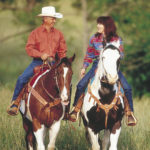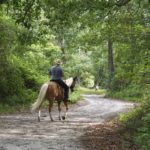For recreational riders, nothing is more enjoyable than traveling across open country on the back of a good horse. Whether you ride by yourself, with several friends, or as part of an organized group, your day in the saddle will be more fun and safe if you keep a few simple rules in mind.

1. Safety in numbers?In addition to the company it provides, riding with a friend is a good idea because help is at your side should you need it. However, if you do wish to ride alone, be sure to let someone know where you are going and how long you’ll be gone. If you need help, this information will help rescuers find you more easily.
2. Equipment check?Before you ride, always check your tack for damage and fit. Thoroughly inspect the saddle for any protrusions that could cause discomfort to you or your horse. Make sure your leather is oiled and flexible, with no cracks or tears. On all equipment, make sure stitching is tight and check all Chicago screws, leather bindings and buckles to make sure they are tightened and functioning properly. Also remember to check your saddle pad for debris that could cause sores on your horse’s back.
3. Group riding?Always consider the well-being of others when riding in a group. Maintain your place in the line of riders and ride at a safe gait. Ask before you pass, and don’t crowd other horses. A safe rule of thumb is to ride one horse-length behind the horse in front of you as some horses become agitated and kick when crowded.
Do not run your horse on the trail. Running upsets other horses and increases the chance of an accident. Also, try not to fall behind.
If the group stops for a water break, make sure all of the horses have a chance to drink before you ride off. Generally, horses prefer to stay together and one may forego quenching its thirst to keep up with the rest ofthe group.
Avoid limbs hanging over the trail. If you have to ride past one, watch the rider ahead and give ample room for the limb to swing back after he or she has passed by. Warn the rider behind you and don’t allow the limb to snap back in their horse’s face. On the trail, courteous behavior equals safe behavior.
4. Environmental care?You are a guest on the land you ride, so don’t leave trash behind or allow your horse to chew on trees or tromp a boggy spot in creeks or springs. Leave the area as you found it.
If you ride on state or federal land, seek advice from officials about the terrain and conditions. Know the regulations regarding trails, where and how you can tie up your horse, and fire rules. If permits are required, make sure that you obtain them in advance.
5. Horse care?Rest your horse often to avoid fatigue, and water it often to avoid dehydration. Keep your cinch snug when riding. When you stop for a rest break, loosen your horse’s front cinch to give your mount time to relax?just remember to tighten it again before you remount. Hooking a stirrup over the saddle horn is a good way to remind yourself that your cinch is loose.
6. Tie safely?Never tie your horse to dead limbs, weak fence posts or other unstable objects on the trail. Always tie the lead rope at least withers-high with only two or three feet between the halter and the tie point. This allows your horse to drop its head and relax without being able to step over its lead rope or eat grass.
Remember to tie a safe distance from other horses and in a clear spot, away from brush, low-hanging limbs or big rocks in which the horse might become entangled.
7. Hobble safely?Use hobbles only if your horse is ?hobble-broke.? Be sure to hobble it where the horse has plenty of room to move around, preferably on level ground that is free of rocks. Avoid hobbling your horse near other horses, especially if they are tied.
8. Don?t play practical jokes.
9. Ride correctly?For your horse’s sake, ride in a balanced position. Lounging in the saddle puts your weight off-center and causes undue stress on your horse’s back and legs. It also increases your chance of falling off should your horse become startled or stumble on rough ground.
When riding uphill or downhill, sit squarely in the saddle. Lean slightly forward when riding uphill and slightly back when riding downhill. This will help your horse balance itself under your weight.
10. Be alert?Recreational riding is supposed to be relaxing, but you still need to pay attention to your surroundings. Watch where you are riding and avoid dangerous ground. If you must ride on slick ground, rock or through thick brush, be especially cautious.
Make your horse take hills at a walk. Some horses naturally want to trot downhill or lunge uphill, which can be dangerous if the ground gives way beneath them. Slow and steady is always the safer choice.
Also watch for snakes, bees, hornets, wasps and other stinging insects. Pay attention to your horse’s body language (an elevated or dropped head, pointed ears, hesitant manner), which can alert you to possible danger.
11. Cool down carefully?If your horse is overheated and you allow it to drink a large quantity of cold water on the trail, be sure to keep the horse moving after it drinks.
All horses should be cooled down after the ride. Intermittently hand-walk and let your horse stand, and introduce water gradually, letting it take a few sips at a time. Continue walking the horse between and after drinks. Allowing an overheated horse to drink large quantities of water can cause it to founder or colic.
12. Respect property?If you wish to ride on private property, always obtain the owner?s permission beforehand and make sure that he or she knows you are on the premises.
Leave gates the way you found them. If they are closed, go through and close them behind you. If they are open, leave them that way. If there are cattle in the pasture you are riding through, do not disturb them.
13. Cross creeks carefully?When crossing a creek, check for a solid crossing area if you are unable to see the bottom. Remember to unfasten your tie-down before crossing. Your horse may panic if ridden into a deep hole, fast current or a boggy spot.
When crossing, keep your horse’s head pointed upstream. Do not let your mount stop in the center of the creek. Though horses may drink at first, they will sometimes begin to paw and then lie down in the water. A safer alternative is to water your horse from the bank prior to crossing.
14. No smoking?Do not smoke on the trail. Too many forest fires have resulted from discarded cigarette butts. Smoke in designated areas only.





